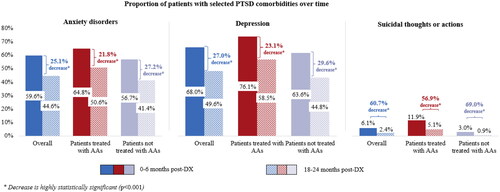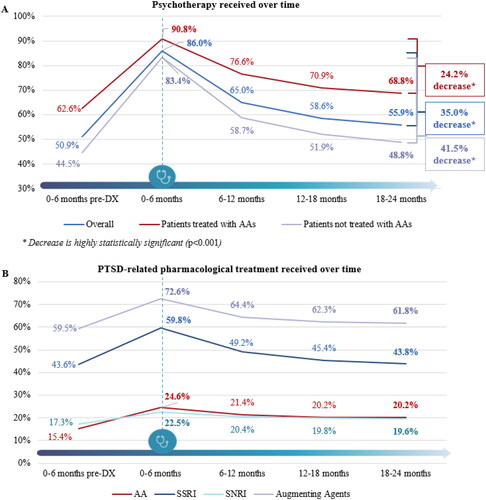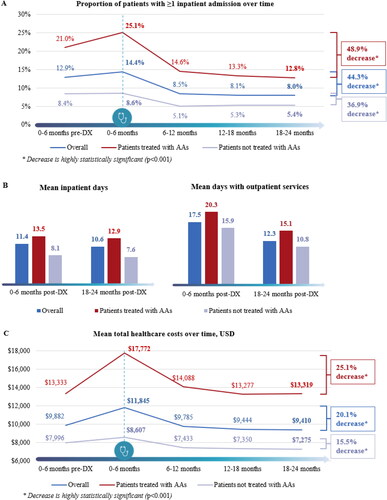Figures & data
Figure 1. Study design. AA, atypical antipsychotic; PTSD, post-traumatic stress disorder; SNRI, serotonin-norepinephrine reuptake inhibitor; SSRI, selective serotonin reuptake inhibitor.

Table 1. Patient characteristics.
Figure 2. PTSD-related symptoms and frequent psychiatric comorbidities pre- and post-PTSD diagnosis in the overall sample1. AA, atypical antipsychotic; DX, diagnosis; PTSD, post-traumatic stress disorder. 1Statistical comparisons were conducted for 0–6 vs 18–24 months post-diagnosis using Chi-square tests; all comparisons were statistically significant (p < 0.001).

Figure 3. Proportions of patients with selected PTSD comorbidities at 0–6 months and 18–24 months post-PTSD diagnosis in the overall sample and subgroups1. AA, atypical antipsychotic; DX, diagnosis; PTSD, post-traumatic stress disorder. 1 Statistical comparisons were conducted for 0–6 vs 18–24 months post-diagnosis using Chi-square tests, separately for the overall sample, the patients treated with AAs subgroup, and the patients not treated with AAs subgroup; all comparisons were statistically significant (p < 0.001).

Figure 4. Treatments received pre- and post-PTSD diagnosis1. AA, atypical antipsychotic; PTSD, post-traumatic stress disorder; SNRI, serotonin-norepinephrine reuptake inhibitor; SSRI, selective serotonin reuptake inhibitor. 1 Statistical comparisons were conducted for 0–6 vs 18–24 months post-diagnosis using Wilcoxon’s signed rank tests, separately for the overall sample, the patients treated with AAs subgroup, and the patients not treated with AAs subgroup; all comparisons were statistically significant (p < 0.001).

Figure 5. HRU and healthcare costs pre- and post-PTSD diagnosis1. AA, atypical antipsychotic; DX, diagnosis; USD, United States Dollar. 1 Statistical comparisons were conducted for 0–6 vs 18–24 months post-diagnosis using Wilcoxon’s signed rank tests, separately for the overall sample, the patients treated with AAs subgroup, and the patients not treated with AAs subgroup; all comparisons were statistically significant (p < 0.001).

PTSD_Claims_Suppl_Materials_036542_25SEP2023.docx
Download MS Word (50.8 KB)Data availability statement
The data that support the findings of this study are available from IBM. Restrictions apply to the availability of these data, which were used under license for this study. Requests for data should be made directly to IBM.
